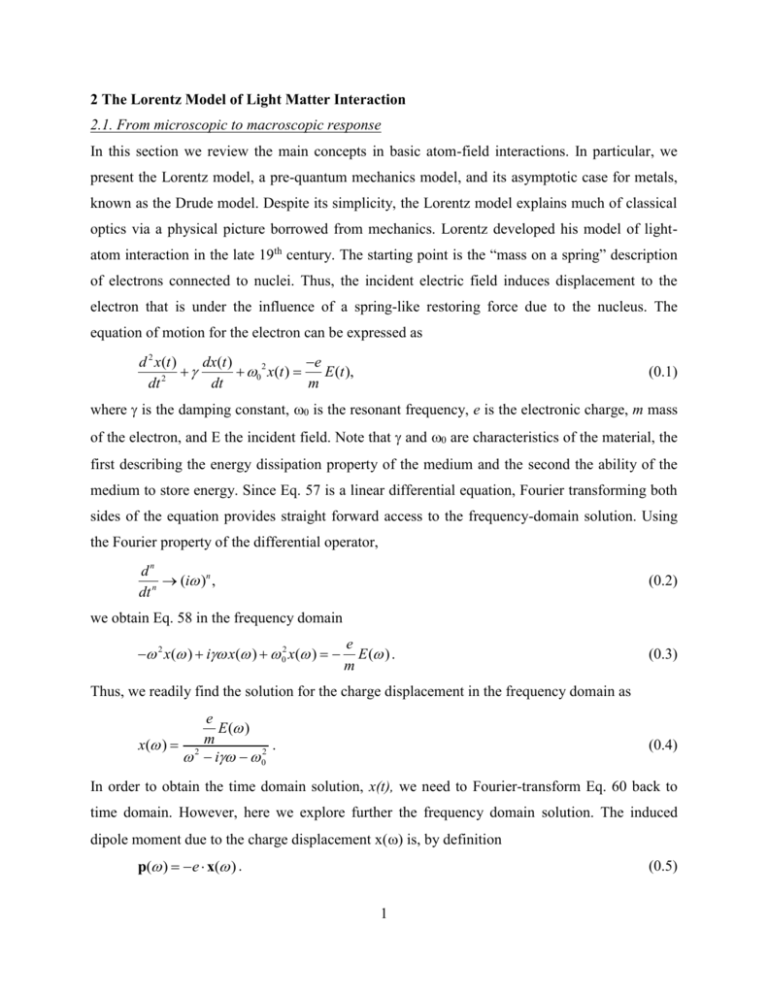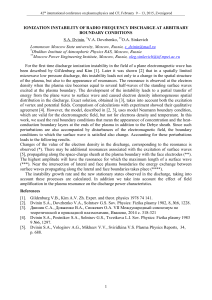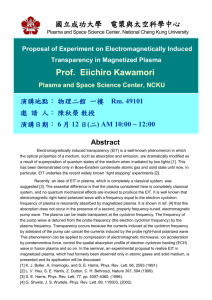
2 The Lorentz Model of Light Matter Interaction
2.1. From microscopic to macroscopic response
In this section we review the main concepts in basic atom-field interactions. In particular, we
present the Lorentz model, a pre-quantum mechanics model, and its asymptotic case for metals,
known as the Drude model. Despite its simplicity, the Lorentz model explains much of classical
optics via a physical picture borrowed from mechanics. Lorentz developed his model of lightatom interaction in the late 19th century. The starting point is the “mass on a spring” description
of electrons connected to nuclei. Thus, the incident electric field induces displacement to the
electron that is under the influence of a spring-like restoring force due to the nucleus. The
equation of motion for the electron can be expressed as
d 2 x(t )
dx(t )
e
0 2 x(t )
E (t ),
2
dt
dt
m
(0.1)
where is the damping constant, 0 is the resonant frequency, e is the electronic charge, m mass
of the electron, and E the incident field. Note that and 0 are characteristics of the material, the
first describing the energy dissipation property of the medium and the second the ability of the
medium to store energy. Since Eq. 57 is a linear differential equation, Fourier transforming both
sides of the equation provides straight forward access to the frequency-domain solution. Using
the Fourier property of the differential operator,
dn
(i )n ,
n
dt
(0.2)
we obtain Eq. 58 in the frequency domain
2 x( ) i x( ) 02 x( )
e
E( ) .
m
(0.3)
Thus, we readily find the solution for the charge displacement in the frequency domain as
e
E( )
x( ) 2 m
.
i 02
(0.4)
In order to obtain the time domain solution, x(t), we need to Fourier-transform Eq. 60 back to
time domain. However, here we explore further the frequency domain solution. The induced
dipole moment due to the charge displacement x() is, by definition
p( ) e x( ) .
(0.5)
1
So far, in Eqs. 59-61 we obtained microscopic quantities, i.e. the atomic-level response of the
system. The macroscopic behavior of the medium is obtained by evaluating the induced
polarization P, which captures the contribution of all dipole moments within a certain volume,
P N p .
(0.6)
In Eq. 62, N is the volume concentration of dipoles (in m-3) and the angular brackets denote
ensemble average. Assuming that all induced dipoles are parallel within the volume, we obtain
P( )
Ne2
E( )
2
.
m 0 i 2
(0.7)
Note that, generally, each atom has multiple resonances, or dipole-active modes, such that Eq. 63
can be generalized to
P( )
E ( )
Ne2
2 i 2
,
m i 0i i i
(0.8)
where the summation is over all modes i, characterized by different resonant frequencies 0i and
damping constants i. The weight i is called the oscillator strength and has the quantum
mechanical meaning of a transition strength. With this in mind, we reverse to the single normal
mode description, which captures the origin of absorption and refraction of materials. The
induced polarization only captures the contribution of the medium itself, i.e. it excludes the
vacuum contribution. Thus,
P 0 E
(0.9)
r 1 n 2 1.
In Eq. 65a, is called the dielectric susceptibility, which generally is a tensor quantity. However,
for isotropic media, we obtain the complex scalar permittivity r r '( ) i r ''( ,
Ne2
1
r ( ) 1
2
m 0 0 2 i
The pre-factor
(0.10)
Ne2
in Eq. 66 has units of frequency squared, 2p , and p is referred to as the
m 0
plasma frequency. The physical meaning of this frequency is discussed a bit later. From Eq. 66,
we readily obtain the real and imaginary parts of r,
2
02 2
( o2 2 ) 2 2
r '( ) 2p 2
( 0 2 )2 2 2
i '( ) 1 2p
(0.11)
Figure 1.7 illustrates the main features of ' and '' vs. frequency. In order to gain further
physical insight into Eqs. 67a-b, we discuss three different frequency regions, as follows.
2.2. Response below the resonance, 0
In this case, Eqs. 67a-b simplify to
2p
1
r '( ) 1 2
0 1 2 / 0 2
(0.12)
2p
1
r ''( )
4
0
1 2( / 0 )2
Since 02 , then ' '' , indicating that absorption is negligible, or, equivalently, that
below the resonance the material is transparent. Further note that d '
d 0 , which, by
definition, defines a region of normal dispersion. In fact, it can be seen that expanding further
the denominator in Eqs. 68a-b, we obtain r '( ) 2 and r ''( ) 3 . This explains why, for
transparent materials, the refractive index dependence on frequency is often approximated by a
quadratic function. Of course, as we approach resonance, this dependence becomes more
complicated.
2.3 Response at resonance,
0
For frequencies that are comparable to 0 , Eqs. 67a-b are well approximated by
p2
r '( ) 1
20
r ''( )
p2
20
0
0
1
/2
2
(0.13)
/2
0
1
/2
2
3
It can be seen that under these conditions, the absorption is significant, 0 , and that the
absorption line has a characteristic shape, called, not surprisingly, Lorentzian line. This shape is
characterized by a central frequency 0 and a full width half maximum of . While 0 has a
clear physical significance of the frequency at which the system “resonates”, or absorbs strongly,
the meaning of is somewhat more subtle. The damping constant represents the average
frequency at which electrons collide inelastically with atoms, which induces loss of energy.
Thus, 1 / col , with col the average time between collisions. Finally, around resonance,
d '
d 0 , which defines anomalous dispersion.
2.4 Response above the resonance, 0
Well above the resonance, the following equations apply:
1
2
/
r ''( ) 1 p 2 2 2
r '( ) 1 p 2
2
(0.14)
Again, the absorption becomes less significant, as expected in a frequency range away from the
resonance. Similarly, the dispersion is normal again, d '
d 0 .
In sum, the Lorentz oscillatory model provides great insight into the classical light-matter
interaction. In the following section, we will investigate the particular situation of metals, when
the charge moves freely within the material.
4
3. Drude model of light-metals interaction
The optical properties of metals were first modeled by Drude in the context of conductivity. In
highly conductive materials, the restoring force in Eq. 57, m 02 x , vanishes, establishing that the
charge can move freely. Under these conditions, we obtain Drude’s model, in which Eqs. 67a-b
reduce to ( 0 0)
p2
r '( ) 1 2 2
(0.15)
r ''( ) 2 p 2
2
Typically 1 / col , i.e. the frequency of collisions is much lower than that of optical
frequencies. In this high frequency limit, r '( ) 1
2p
2
and r ''( )
2p
3
. From the
Fresnel equations, we can derive the power reflection coefficient. Thus, for normal incidence, the
intensity-based reflectivity is
2
n 1
R( )
,
n 1
(0.16)
where n is the (complex) refractive index. Since n r , Eq. 72 becomes
R( )
r ' i r '' 1
r ' i r '' 1
2
(0.17)
Figure 7 illustrates the frequency dependence of ' , '' , n’, n’’ and R for various values of p
and .
Interestingly, at p , r '( ) vanishes. In order to gain a physical understanding of
the plasma frequency p , let us consider a thin film of metal (Fig. 8a). The applied electric field
induces a polarization P 0 E , with r 1 . Tuning the frequency of the incident field to
the plasma frequency, r 0 , 1 , and P 0 E . On the other hand, the induced
polarization is the total charge times the displacement per unit volume,
P N e x
(0.18)
Therefore, the electric field is
5
E
P
0
Ne
0
(0.19)
x
If we construct the electric force due to the charge displacement, F eE , we obtain
F
Ne2
0
x
(0.20)
ke x.
In Eq. 76, we define ke as the “spring” constant of the restoring force. Thus, by definition, the
system is characterized by a resonant frequency, p ke / m . This is the plasma frequency
associated with the thin film,
p
Ne2
.
m 0
(0.21)
From Maxwell’s equations, we have that H
D
E P
0
. At plasma frequency,
t
t t
P 0 E , and, thus, the magnetic field vanishes. This indicates that there is no bulk propagation
of electromagnetic field. The quantum of energy associated with these charge oscillations at
plasma frequency is p and the respective quantum particle is called plasmon. Light scattering
on plasma oscillations, including in nanoparticles (Figure 8b) can be described as a photonplasmon interaction.
6
Further reading
1. J. D. Jackson Classical electrodynamics (Wiley, New York, 1999).
2. M. Born and E. Wolf Principles of optics : electromagnetic theory of propagation,
interference and diffraction of light (Cambridge University Press, Cambridge ; New York,
1999).
3. R. P. Feynman, R. B. Leighton and M. L. Sands The Feynman lectures on physics
(Pearson/Addison-Wesley, San Francisco, 2006).
4. M. Bass and Optical Society of America. Handbook of optics (McGraw-Hill, New York,
1995).
5. L. D. Landau, E. M. Lifshits and L. P. Pitaevskii Electrodynamics of continuous media
(Pergamon, Oxford ; New York, 1984).
6. R. N. Bracewell The Fourier transform and its applications (McGraw Hill, Boston, 2000).
7
Figure Captions
Figure 1. Interface between two media.
Figure 2. Mutually orthogonal vectors.
Figure 3. Group and phase velocity.
Figure 4: Two media of refractive index n1 and n2 separated by the x-y plane. The subscripts i, t, r
refer to incident, transmitted, and reflected light, respectively.
Figure 5. Decaying evanescent field.
Figure 6. Propagation between two media at Brewster angle (TM polarization only).
Figure 7. Frequency dependence of dielectric permeability and reflectivity around the plasma
frequency (p =10, =1) .
Figure 8. Polarization induced in a thin layer of metal (a) and a nanoparticle (b) at plasma
frequency.
8









